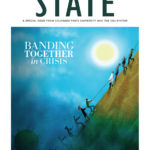Photo: Mary Neiberg
My mother died on March 1.
After I contacted my immediate family, I did what has become commonplace among friends my age: I posted my loss on Facebook. The COVID-19 pandemic forced me to cancel plans for my mother’s memorial, which had been set on her birthday in early April. It would have been the gathering we needed for reflection and mourning together, but would have required the travel and close contact we were ordered during those weeks to avoid. So, at that moment, social media was an important outlet for my remembrance and grief.
My mom died in hospice care at a local nursing home, shortly before COVID-19 compelled that facility, and many like it, to lock down in an effort to protect residents. I felt a strange gratitude that my mom died before the shutdown. It shook me to imagine saying goodbye not at her bedside, but through a window, or worse, the screen of a computer. Like many of us, I have since watched loss invade our lives through those screens.
The staggering number of deaths, the massive unemployment, and the loss of health care and homes have been devastating. I have also watched the losses my students have experienced. Last spring, they lost graduation day, jobs and internships, physical contact with their friends and loved ones, and any certainty about what comes next.
As the pandemic drags on, our digital lives carry a new collective weight, and we did not build these lives to carry such a load. The result is a consolidation on our screens of hope, inspiration, and humor, along with cynicism, mistrust, and anger. Some of my students during the first few months were finding a theme lying under all that – grief, both personal and shared.
Grief is nothing new in social media, as we were reminded in late May. We watched in disbelief, and then horror and outrage, the video of a police officer pressing his knee into the neck of George Floyd, killing him, while onlookers pleaded for the officer to stop. For anyone who has posted or followed hashtags such as #BlackLivesMatter and #SayHerName, this was less revelation than repetition. In pictures, signs, videos, and petitions, we have seen a mix of human emotions in response to injustice, including grief. A picture on Twitter drove this home: At Floyd’s funeral, the mother of Ahmaud Arbery, who was killed by racist vigilantes while jogging, is shown comforting the sister of Botham Jean, who was killed in his home by an off-duty police officer.
Grief covers the escalating number of COVID-19 deaths. It covers lost jobs and savings and promises. It is in the hearts of those who had to see the last moments of a loved one’s life on a screen.
So a question for my media students has emerged: If we focused our reporting and storytelling on the grief, and not the cacophony of division, what would change?
Our society often seems allergic to grief, something to get past. But why? As novelist and Nobel laureate Toni Morrison said after losing her son to cancer, “I want what I got. Memory. And work. And some more ibuprofen.” Embracing grief might be what we need in our social media, and in our society as a whole, to separate the heat from the light in our discourse. Yes, of course, grief can be performed and manipulated like any other emotion. But genuine grief carries something that is hard to miss online – humility.
When I shared my own grief on Facebook, I felt vulnerable, humbled by my sadness and disorientation. Friends responded with the sympathy, kindness, and love I needed. If I think about all the ideologies, all the tax brackets, all the privileges, and lack thereof, represented in those who spent even a second responding to my grief, it is a little ibuprofen for the soul.
I engage my students in these questions and teach technical skills in social media storytelling, because what we say and do on these platforms is not only real, it is life. A life that reflects who we are, both physically and digitally. And perhaps sitting with our grief, and noting it there behind the other emotions, will humble us, make it easier to do good. Until life, and the stories it fosters, is better for everyone.
Michael Humphrey (Ph.D., ’17) is an assistant professor in CSU’s Department of Journalism and Media Communication. He teaches and researches social media storytelling. Humphrey was honored with a 2019 Best Teacher Award from the CSU Alumni Association.





